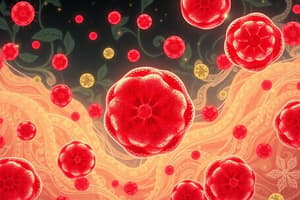Podcast
Questions and Answers
Which of the following correctly describes the intrinsic pathway of the coagulation cascade?
Which of the following correctly describes the intrinsic pathway of the coagulation cascade?
- It involves the activation of factor XII, which activates factor XI, which in turn activates factor IX. (correct)
- It is triggered by exposure of collagen in the damaged blood vessel.
- It is slower than the extrinsic pathway.
- It is initiated by the activation of factor VII.
What is the role of thrombin in the coagulation cascade?
What is the role of thrombin in the coagulation cascade?
- It directly activates factor XIII, which stabilizes the fibrin clot.
- It activates factor VII, initiating the extrinsic pathway.
- It converts fibrinogen to fibrin, forming the meshwork of the clot. (correct)
- It activates factor X, leading to the production of prothrombin activator.
Which of the following is NOT a factor involved in the common pathway of the coagulation cascade?
Which of the following is NOT a factor involved in the common pathway of the coagulation cascade?
- Factor IX (correct)
- Factor XIII
- Factor X
- Factor VIII
What is the primary role of the coagulation cascade?
What is the primary role of the coagulation cascade?
Which of the following is a potent anticoagulant, inhibiting the coagulation cascade?
Which of the following is a potent anticoagulant, inhibiting the coagulation cascade?
Flashcards are hidden until you start studying
Study Notes
Intrinsic Pathway of the Coagulation Cascade
- The intrinsic pathway is initiated by damage to blood vessels and exposure of collagen, leading to the activation of factor XII.
- This pathway involves multiple factors including VIII, IX, and X, ultimately contributing to the formation of a fibrin clot.
Role of Thrombin
- Thrombin is a key enzyme that converts fibrinogen into fibrin, facilitating the formation of a stable blood clot.
- It also activates factors V, VIII, and XIII, amplifying the coagulation cascade and promoting further clot formation.
Factors in the Common Pathway
- The common pathway includes factors X, V, and prothrombin, leading to thrombin production and ultimately, the conversion of fibrinogen to fibrin.
- Factor XIII is also essential for stabilizing the fibrin mesh but must be activated by thrombin.
Primary Role of the Coagulation Cascade
- The primary role of the coagulation cascade is to prevent excessive bleeding by forming a stable blood clot in response to vascular injury.
- It ensures rapid and localized responses to injuries, minimizing blood loss.
Potent Anticoagulant
- Antithrombin III is a potent anticoagulant that inhibits several factors in the coagulation cascade, including thrombin and factor Xa.
- This protein is crucial in maintaining the balance between coagulation and anticoagulation in the bloodstream.
Studying That Suits You
Use AI to generate personalized quizzes and flashcards to suit your learning preferences.




